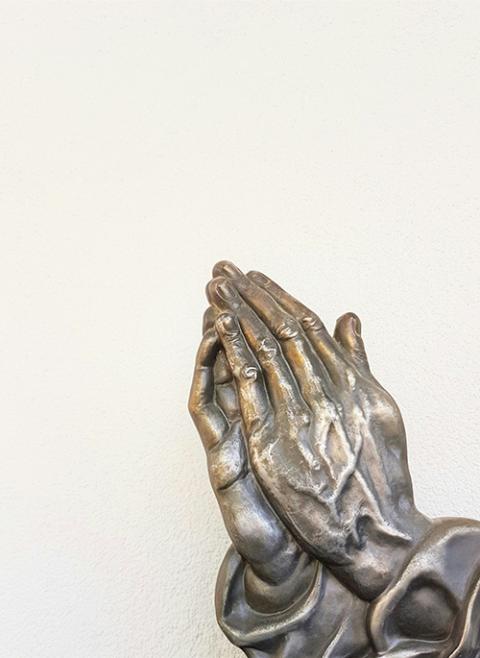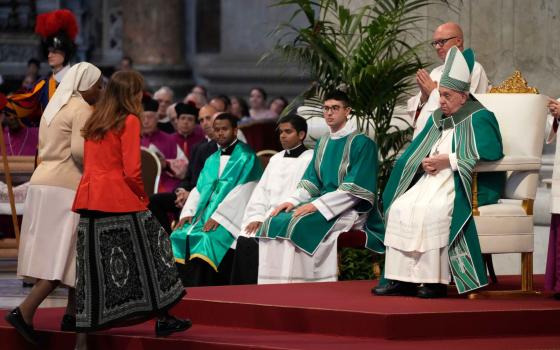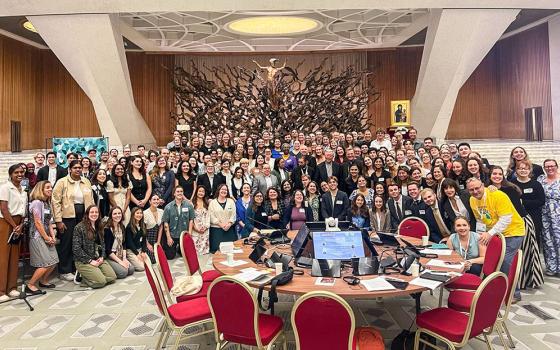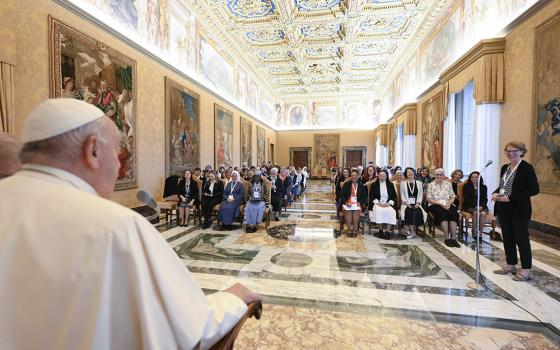
Pope Francis and leaders of the assembly of the Synod of Bishops listen to a speaker in the Vatican's Paul VI Audience Hall on Oct. 13, 2023. (CNS photo/Lola Gomez)
As the official synodal process enters its fourth year, the Vatican recently released the document, the instrumentum laboris, to guide discussions for the October 2024 synod. The document was relatively stunning in its admission of challenges, beauty of language on the Trinity and Christ and mission; and, for its announcement that opening the diaconate for women will not be a topic of discussion at this coming October synod in Rome.
But there were many omissions — too many for a document that was to lay out the next steps in the "listening" process called synodality.
When it comes to my beloved Catholic Church, I am a realist. I did not expect there to be a decision on women deacons finalized and announced after the October synod. I did, however, expect input from experts, robust dialogue, learning and discerning among those present.
The synthesis report from last October contained 81 proposals. Those proposals included bishop accountability, enhancing priest engagement in the synod, more formation for laity and priests, establishing ministries for youth in local parishes, and increasing awareness of Catholic social doctrine, among many others. The proposals were contained within the document's three major parts: "The Face of the Synodal Church," "All Disciples, All Missionaries," and "Weaving Bonds, Building Communities."
These proposals were the outcome of global listening sessions in parishes, schools and other institutions; with results compiled into diocesan, national and then continental reports. These reports from around the world were reviewed, analyzed and summarized in the Document for the Continental Stage. That information then led to the instrumentum laboris, which guided the discussions for the October 2023 in Rome.

A woman holds a sign in support of women deacons as Pope Francis leads his general audience in St. Peter's Square Nov. 6, 2019, at the Vatican. (CNS/Paul Haring)
Each of these reports contained the aspirations and frustrations of Catholics from around the world and provided a foundation for future listening and discussion. The Document for the Continental Stage, for example, opened with the call for us to "enlarge the space of your tent, spread out your tent clothes unsparingly; lengthen your ropes and make firm your pegs" (Isaiah 54:2), urging the church to expand the horizons of our structure and mission.
This month, the instrumentum laboris for the October 2024 synod discussions in Rome was released, with 112 separate assertions. Paragraph 17 notes:
While some local Churches call for women to be admitted to the diaconal ministry, others reiterate their opposition. On this issue, which will not be the subject of the work of the Second Session, it is good that theological reflection should continue, on an appropriate timescale and in the appropriate ways. The fruits of Study Group 5, which will take into consideration the results of the two Commissions that have dealt with the question in the past, will contribute to its maturation.
Here's my fundamental issue with this declaration. The synthesis report from last October included 81 separate proposals. Of those 81, the only one itemized as "not … the subject of work of the second session" is one regarding women's ordination as deacons. That, along with Pope Francis' "no" response during a recent interview about whether little girls can look forward to being deacons in the future, is a bit chilling. While there is language about continued theological reflection — it does seem odd to call out this issue as the only one off the synod table.
Also odd is the rationale. The fact that some churches call for women's ordination and others do not is an inadequate reason for not discussing an issue. I would argue every one of those 81 proposals has some support and some opposition. Since when has 100% agreement in the Catholic Church been a criterion for moving forward? Aside from a handful of the obvious, I can't name a single theological, social, political or moral issue all Catholics can agree with. (Even the "obvious" might be a challenge.)

(Unsplash/Deb Dowd)
Here's the practical impacts of this decision. Catholics around the world are hopeful about changes that could arise from collective listening to the Holy Spirit. People have spent hours engaged in the process; speaking from the heart about what they love about the church — and what breaks their heart. My simple expectation is to continue the process. We know the church is proud of "thinking in centuries" and that change comes slowly. It is, however, even slower when you don't bother to fully discuss an issue in an ongoing listening and discerning process.
Fundamentally, the church needs women deacons. I attended Seattle University School of Theology and Ministry and the Jesuit School of Theology Sabbatical Renewal Program. I also participated in the Loyola Institute of Spirituality Spiritual Exercises for Everyday Life. In each of these sessions, as well as in my parishes, I have met many women capable of serving as deacons, and frankly, as priests.
In my years of parish involvement, and visiting parishes all over the country, I have been to 80 different parishes. I have seen many talented, effective and capable priests. There are, however, many who, due to age, overwork, lack of support, and personal human shortcomings, are not as effective as they could be. Further, our priest shortage is being somewhat alleviated by the many foreign priests in the United States. One could argue these priests, dedicated and loyal, could be more effective serving in their own cultural and social context.
Priests are getting fewer, and older. A 2012 study showed the average age of Catholic priest was 63, with more than 40% over age 65. The aging issue holds true for deacons as well. I attended an event of Discerning Deacons, and the speaker, Deacon Bill Ditewig noted research that reveals that less than 1% percent of U.S. deacons are under 40, 4% under 50; 41% are ages 60-69, and 36% are 70 or above.
Advertisement
Many of the talented Catholic women I met in theological school and other venues have decided to remain in the Catholic Church to serve in schools, Rite of Christian Initiation of Adults programs, formation, as chaplains, and other leadership positions. Many, however, packed up their God-given gifts and taken them to be fully utilized in the Episcopal church, and other faith traditions.
How tragic is it: as our priests and deacons age, we rely increasingly on foreign priests, we fervently pray for an "increase in vocations," and yet do not even discuss unleashing a resource and solution right in our midst? Imagine the impact of a woman deacon officiating alongside a parish priest.
I can attest to the impact, for the church I attended in Seattle had a woman, Patty Repikoff, serving as pastoral life director. The energy, relationships, connections and mission of the parish were greatly enhanced by her homilies, pastoral skills and talents.
Not even discussing this issue in October is a major mistake. Jesus told us, the Spirit is like the wind, we do not know where it has been, or where it is going (John 3:8). How do we discern its direction without dialogue? The apostle Paul asked, "How can they hear without someone preaching to them?" (Romans 10:14).
I would ask, "How can we discern, without listening?"







